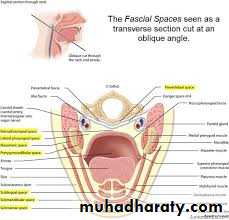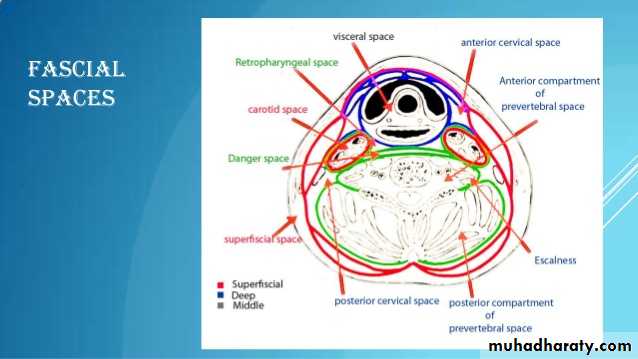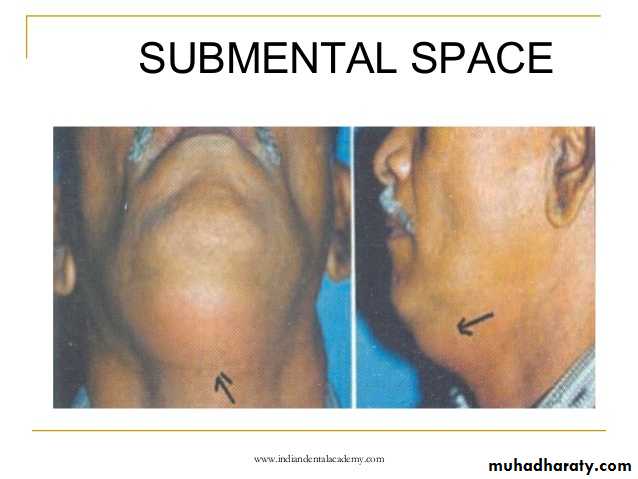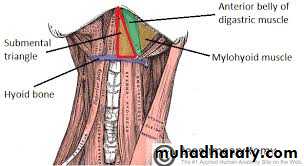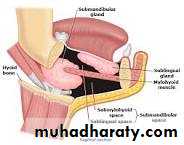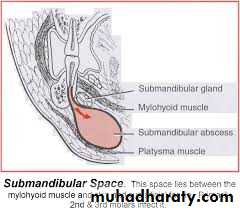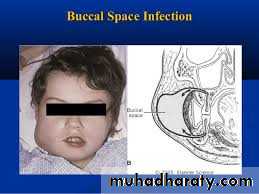Fascial spaces
Fascial spacesFascial spaces are potential spaces, they are surrounded by muscles, loose C.T. and bone, they contain different anatomical structures and they are separated by collection of pus, blood or by surgeon's finger.
They are continuous and infection spreads readily from one space to another.
A thorough knowledge of the anatomy of the face and neck is necessary to predict the pathways of spread of infections.
Fascial spaces are sometimes classified as primary; which are directly adjacent to the origin of the odontogenic infections, and secondary; that become involved following the spread of infection to the primary spaces.
Spaces in relation to the lower jaw
1. Submental spaceAnatomic boundaries : this space lies between the Mylohyoid muscle above, skin, subcutaneous tissue, PIatysma muscle and deep cervical fascia below, laterally by tower border of the mandible and anterior bellies of Digastric muscle.
It contains submental lymph nodes embedded in adipose tissues.
2. Submandibular apace
Anatomic boundaries: it is bounded by Mylohyoid muscle superiorly, anterior and posterior bellies of Digastric muscle inferiorly, Mylohyoid, Hyoglossus and Styloglossus muscles medially, laterally the space is bounded by the skin, superficial fascia, Platysma , deep fascia and the lower border of the mandible.This space contains the Submandibular salivary gland and lymph nodes in addition to facial artery and vein, lingual and Hypoglossal nerve as they course deep to submandibular salivary gland.
3. Sublingual space
Anatomic boundaries: this is a V-shaped space, it is bounded anteriorly and laterally by the mandible, superiorly by sublingual mucosa, inferiorly by the Mylohyoid muscle and medially by muscles.Genioglossus, Geniohyoid and Styloglossus
4. Buccal space
Anatomic boundaries: bounded by the Buccinator muscle and bucco-pharyngeal fascia medially, skin of the cheek laterally, labial musculature anteriorly, zygomatic arch superiorly, the inferior border of the mandible inferiorly and the pterygomandibular raphe posteriorly.It contains the buccal pad of fat, facial artery and the parotid duct.
4. Masticator spaces :
These are well differentiated spaces but they communicate with each other as well as with the buccal, submandibular and pharyngeal spaces. They are:• Masseteric space.
• Pterygomandibular space.
• Temporal space.
Masseteric apace infection (also called submasseteric space) :
Anatomic boundaries :this space lies between the outer surface of the ascending ramus of the mandible medially, the Masseter muscle laterally and the parotid gland posteriorly.Pterygomandibular space infection:
Anatomic boundaries : it is bounded medially by the Medial Pterygoid muscle, laterally by the medial surface of the ramus of the mandible. Lateral Pterygoid muscle superiorly, parotid gland posteriorly and the pterygomandibular raphe and superior Constrictor muscle of the pharynx anteriorly.Temporal space infection:
Anatomic boundaries :the Temporalis muscle divides this space into two spaces:
• Superficial temporal space : between the muscle and temporal fascia.
• Deep temporal space : between the muscle and the temporal bone.
The temporal space is contiguous with the pterygomandibular and masseteric space .
5. Lateral pharyngeal space infection (also termed parapharyngeal space)
Anatomic boundaries: this space extends from the base of skull to the hyoid bone, it is conical in shape, the lateral boundaries include the medial surface Medial Pterygoid muscle, the medial wall is the Superior Constrictor muscle, Styloglossus muscle, Stylopharyngeus muscle and the Middle Constrictor muscle of the pharynx. Posteriorly by the parotid gland and anteriroriy by pterygomandibular raphe.This space can be divided into two compartments; anterior and posterior, the latter contains the carotid sheath.
6. Retropharyngeal space infection
Anatomic boundaries: extend from the base of the skull to the upper mediastinum (C6-T1), it is bounded anteriorly by posterior wall of the pharynx and posteriorly by the Alar fascia.7. Peritonsillar abscess or Quinsy :
Anatomical boundaries: it is localized between the C.T. bed of the faucial tonsil and the Superior Constrictor muscle of the pharynx.spaces in relation to the upper jaw
I. Upper lipInfections of the upper incisors and canines can spread to the upper lip usually on the oral side orbicularis Oris muscle and points in the vestibule.
Infection of the upper lip can lead to serious complications like orbital cellulitis or cavernous sinus thrombosis by extension of infection through the superior labial vein to anterior facial vein to ophthalmic vein to cavernous sinus.
Incision for drainage is made near the vestibule intraorally.
2. canine fossa
Anatomical boundaries :it lies between the canine fossa and the muscles of the facial expression .
3. Buccal space
Infections spread from infected upper molar teeth where it spreads buccally above the attachment of Buccinator muscle.4. Infratemporal space infection
Anatomical boundaries: this space is bounded laterally by the ramus of the mandible and the Temporalis muscle, medially by lateral pterygoid plate, superiorly by infratemporal surface of the greater wing of the sphenoid.It is traversed by the maxillary artery and contains pterygoid venous plexus. It represents the upper extremity of the pterygomandibular space.

